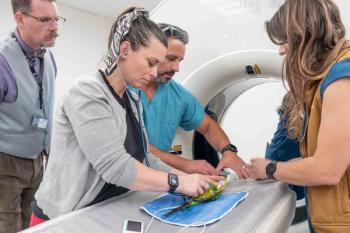
Small animal thoracic radiology: Beyond pulmonary patterns (Proceedings)
Pulmonary patterns have the bane of radiology since the beginning of time (1896 when x-rays were discovered). Pulmonary pattern recognition is the most difficult concept to teach and the most difficult and frustrating to learn, yet, the pattern itself is only part of the puzzle.
Objectives of the Presentation
1. Provide practitioners with a basic interpretation paradigm for the evaluation of the small animal thorax.
2. Provide practitioners with a basic overview and a simplified approach for describing pulmonary abnormalities.
3. Evaluate anatomic distribution of disease processes as a valuable method for assessing pulmonary abnormalities.
4. Think in terms of next step and how to get a cytologic diagnosis in as non-invasive a fashion as possible.
Key Etiologic and Pathophysiologic Points
1. Technical factors including technique, phase of respiration and the positioning of the patient have to be taken into account when interpreting thoracic radiographs.
2. Different disease processes will go through various pulmonary patterns depending on the stage and severity of the disease.
3. One must think in terms of recheck thoracic radiographic evaluation on a daily basis if necessary to determine the response of the patient to therapy or the progression of the disease process.
4. The pathophysiology of many pulmonary diseases do not equate with a specific pulmonary pattern.
Key Clinical Diagnostic Points
1. One should try to compartmentalize radiographic abnormalities into extrathoracic, pleural, pulmonary and mediastinal (including cardiac), recognizing that any disease can have multicompartmental components.
2. One should try to determine the anatomic location of pathology within the lung first and foremost and then worry about the pulmonary pattern. Even though there may be several pulmonary patterns, one must identify the dominant pattern in order to evaluate for differentials.
3. Interstitial lung patterns will not exfoliate using transtracheal washes or bronchoalveolar lavage. Sometimes US guided lung aspirates may be beneficial for cytology, but this is not 100%.
Key Therapeutic Points
1. Follow-up radiographs should be obtained in rapid succession if warranted (within the same day or within 24 to 48 hours).
2. Edema from cardiogenic causes responds rapidly to diuretics unless the dog or cat has been in chronic failure and is resistant to standard diuretic therapy.
3. Edema from non-cardiogenic causes will not clear rapidly, but may take several days to see significant resolution of pulmonary abnormalities.
4. Key Prognostic Points
5. Progressive alveolar disease associated with respiratory distress, DIC, pancreatitis and oxygen toxicity carries a grave prognosis.
Pulmonary patterns have the bane of radiology since the beginning of time (1896 when x-rays were discovered). Pulmonary pattern recognition is the most difficult concept to teach and the most difficult and frustrating to learn, yet, the pattern itself is only part of the puzzle. The recognition that the disease is actually within the pulmonary parenchyma and not in the pleural space, extra-thoracic structures or the mediastinum is the first step key step. To this end we will build on the basic interpretation paradigm of the thorax and look at the steps for evaluating the thoracic radiographs in dogs and cats. Technique and positioning are critical in this process and should be the cornerstone for high quality thoracic radiographs. Finally, we will tackle pulmonary patterns with an emphasis on describing what is on the thoracic radiographs and equally important, recognizing anything that is missing from the thoracic radiograph (a structure that I normally see that is not apparent on the images that one is interpreting).
In spite of these rather negative statements, thoracic radiography is still the most common first line assessment for diseases and conditions of the pleural space, pulmonary parenchyma and mediastinum. However, pulmonary patterns are one of the most frustrating areas for veterinarians. The reality is that pulmonary patterns do not equate to pathologic processes and any given disease can progress or regress through several pulmonary patterns or even have a combination of pulmonary patterns at the same time. The purpose of this lecture will be to rethink the use of pulmonary patterns and take a fresh approach at the evaluation of the pulmonary parenchyma in the dog and cat. Differences between the two species will be stressed. The emphasis will be placed on anatomic localization, description of the pulmonary change and then formulation of a reasonable differential diagnosis list. Cases will be used to illustrate the presentation important points.
At a minimum, left and right lateral radiographs should be made for every patient. A three-view thorax has become the standard of care in veterinary medicine. There is a "blind spot" ventral and central along the cardiac silhouette on the VD/DV images where mass lesions may not be seen. Recumbent sided lesions (e.g. right middle lung lobe lesion with the patient in right lateral recumbency) with border effacement from surrounding atelectasis can be up to 5 cm in size and still not be seen.
The pulmonary parenchyma has always been the "thorn in the side" for practitioners and students alike. The easiest way to evaluate the pulmonary parenchyma is based on peak inspiratory films. The first question asked is: Are the lung abnormally radiolucent or radiopaque (or mixed)? If the lung(s) are radiolucent then the most common reason is hypovolemia from any cause, followed by pulmonary thrombo-embolism. Causes of focal radiolucencies would include: pulmonary bulla, blebs, cavitated lesions (granulomas or tumors), hematocoeles or pneumatocoeles and pulmonary thrombo-embolism involving a specific lung lobe.
If the lungs are too radiopaque (white), then the first thing to consider is where? Describe the anatomic location of the abnormality including lung lobes involved and if there is partial lobar involvement, is the change peripheral, mid-zone or hilar? Next, is there a contralateral or ipsilateral mediastinal shift noted on the VD/DV image (assuming the VD/DV image is straight and the sternum is superimposed over the thoracic vertebrae? Now we will approach the pulmonary patterns. We are going to work through the patterns from the easiest to identify to the most difficult (actually what we will be left with and thereby an easy diagnosis). The alveolar pattern is the easiest to diagnose. The components of an alveolar pattern include: uniform soft tissue opacity, the presence of air bronchograms, a lobar sign, border effacement with the heart or diaphragm and border effacement with the pulmonary vessels and outer serosal wall of the airways. The next pattern is the bronchial pulmonary pattern. In general, bronchial patterns are generalized and you are looking for thickened small airways that will create "rings and lines". The central airways will always be prominent and in older dogs can mineralize. This can be quite striking in appearance. Try to evaluate for the presence of small airways in the peripheral aspect of the lungs or the thin section of the lungs. Next, is the vascular pulmonary pattern. There are three options for increased opacity. Increase in size of the pulmonary arteries (heartworm disease), increase in size of the pulmonary veins (left heart failure) or increase in size of both pulmonary arteries and veins (over circulation from left to right congenital cardiac shunts, arteriovenous fistulas, heart failure in cats, or volume overload in renal failure patients). If none of the above fits, you are left with the "treaded" interstitial pattern. The interstitial pulmonary pattern can be classified as either a structured (miliary or nodular) or unstructured ("hazy" increase in background lung opacity with loss of normal pulmonary and great vessel border definition). Lastly, assign some degree of severity to the pulmonary pattern (mild, moderate and severe). If you are arguing over a mild unstructured interstitial pulmonary pattern, forget it. You are not going to do anything about it anyway. So my final report may go something like this: "There is an alveolar pulmonary pattern that has a mid zone and peripheral distribution (cranioventral) within the right cranial and middle lung lobes, moderate in severity." Based on the anatomic location, bronchopneumonia or aspiration pneumonia becomes the top differentials, particularly with clinical signs of fever, labored breathing or a history of vomiting and/or regurgitation, (Table 1).
Table 1: Pulmonary Patterns
The caveats for lung patterns are:
a) The pulmonary pattern will not correlate to a pathognomonic histological diagnoses (never has, never will)
b) Pulmonary patterns are often mixed for a given disease. Decide what pattern is dominant.
c) The pulmonary pattern may represent a disease in transition (interstitial to alveolar or vice versa).
d) Avoid jargon terms such as consolidation or infiltrate as there are no good definitions for these terms and there are no differential lists to look up for these terms. Additionally, they both just mean increased soft tissue opacity within in the lung, are generic and even more non-specific than a pulmonary pattern.
e) Avoid broncho-interstitial. This is not to say that a disease process (e.g., heartworm disease or PIE) cannot have both a bronchial and interstitial component, but again broncho-interstitial is not a category to look up in a table in a book on radiology. You will have to decide whether or not the predominant pattern is bronchial or interstitial in order to sort through a justified, prioritized differential list.
Finally, the mediastinum is to be evaluated. I divide the mediastinum into a cranial third, middle third and caudal third. Important structures in the cranial third include lymph nodes (sternal and cranial mediastinal), thymus, trachea and esophagus. Important structures within the middle mediastinum include the esophagus, tracheal termination (carina), tracheobronchial lymph nodes and the cardiac silhouette. Important structures in the caudal mediastinum include esophagus, aorta and caudal vena cava.
Summary
• Technical quality impacts the ability to interpret thoracic radiographs
• A systematic approach to film review is critical for complete assessment
• Adequate time needs to be give to the review of thoracic radiographs
• Multicompartmental disease can be confusing at first, but take each compartment separately and then tie them together potentially as one disease process
• Pulmonary abnormalities should be described in terms of anatomic localization prior to a pulmonary pattern description
• Interpretation of thoracic radiographs is fun!
Suggested Reading/References
Thrall, DE. Veterinary Diagnostic Radiology, 5th Edition. WB Saunders: 2008.
Dennis R, Kirberger RM, Wrigley RH and Barr FJ. Handbook of Small Animal Radiological Differential Diagnosis, WB Saunders, 2001.
O'Brien RT. Thoracic Radiology for the Small Animal Practitioner, Teton NewMedia, 2001.
Schwarz T and Johnson V. BSAVA Manual of Canine and Feline Thoracic Imaging. BSAVA, 2008.
Newsletter
From exam room tips to practice management insights, get trusted veterinary news delivered straight to your inbox—subscribe to dvm360.






